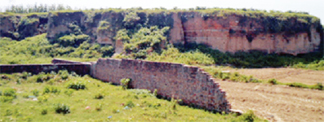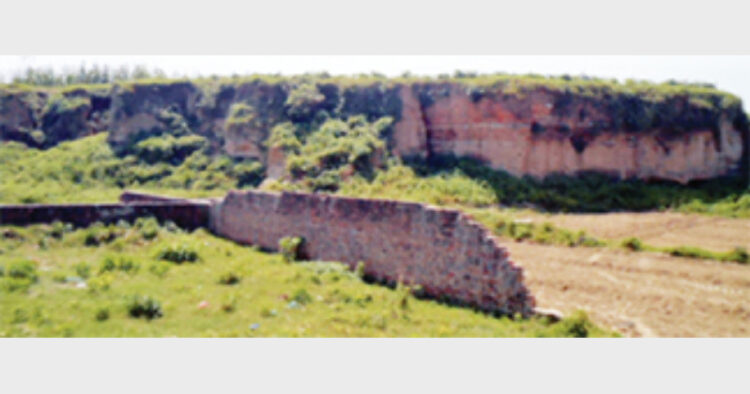 How can we expect the people to respect progressive women if we cannot give due recognition to a place documented as being the birthplace of the first ever progressive woman of Bharat, Draupadi
How can we expect the people to respect progressive women if we cannot give due recognition to a place documented as being the birthplace of the first ever progressive woman of Bharat, Draupadi
Neera Misra
This is the sad story of Kampilya’s archaeological exploration and excavation journey since Archaeological Survey of India’s (ASI’s) Alexander Cunningham stepped on this soil of immense antiquity, also called ‘Chhoti-Kashi’. He undertook an intensive all India survey and documented details of whatever information he got about ancient past. This was a blessing because, for the first time, we had written records of our revered places and antiquities, but also a curse, as it also led to massive pilferages and smuggling. So, destruction of our cultural and civilisation of wealth continued systematically.
In March 1878, Alexander Cunningham visited Kampilya (ASI Reports 1875-76; 1877-78, vol. IX, p-12) and identified it with ancient Kampilya, the capital of Southern Panchala. Kampil became a protected site under ASI in 1920 (vide no: UP 1669 M/1133, dated 27.12.1920). It is located in the current District of Farrukhabad in Uttar Pradesh. Cunningham’s visit highlighted the importance of this Vedic period city. This gradually started changing the character of its history and destruction process of Kampil’s original heritage started. Original temples became private property and those with sculptured walls and interiors were either demolished for gains or converted to new Jain temples.
Since Kampilya cannot be archaeologically ignored, since 1965 to 2011, several explorations and
excavations were undertaken. They have amply proved not just huge Painted Grey Ware (PGW) Culture, but also pre-PGW cultural findings. Prof BB Lal reported Painted Grey Ware and Northern Black Polished Ware from this site during his 1954-55 explorations of cities of Mahabharata era. (Ancient India, No. 10 & 11, p-140). In 1965-66, when it was locally also known as Draupadigarh, Dr VN Mishra of Deccan College, Pune explored the site. He reported large quantity of Painted Grey Ware and other associated wares. IAR 1965-66, (p-48) reports Northern Black Polished Ware and medieval glazed ware were also found. Dr KK Sinha of Department of Ancient Indian History and Archaeology, BHU, excavated six trenches in different parts of the mound and found 2.40 metres thick deposit of Painted Grey Ware above the natural soil, like that of Mahabharata period. He concluded, that the place needs re-checking for wider understanding. (IAR 1975-76, Pp 51-52).
The most exhaustive work was done by an Italian team under the “Kampilya Mission” in 1997 and 1999. The Ca, Foscari University of Venice, CNR of Padua and the VAI Sonlus (an NGO) conducted the first field survey under the direction of Bruno Marcolongo and Gian G Phillippi. In this mission, they verified the regular rectangular shape of the
layout of Drupad Kila, fort of King Drupad, as it was called by the villagers. In fact, Kampilya has been mentioned in Mahabharata as the capital of the southern Panchala Kingdom, at the time of Drupad. The walls of the city measure 78 by 660 metres and are perfectly oriented towards the point of the compass. What is very surprising about this layout,
orientation and size is that another city recently discovered in Gujarat, Dholavira, has precisely the same
feature. The plans for Kampilya-Drupad Kila and Dholavira coincide perfectly, something recognised also by Dr Bisht, Director of Dholavira excavations. And this is a problem for our archaeologists, because as per their
current available research, Dholavira was a town of the
Indus-Sarasvati, so far considered by them as 2,000 years older than Kampilya. This fact offered evidence of the continuity of only one urban model from the Indus-Sarasvati to the Ganges civilisations in the time frame of two millennia.
At the end of 1999, along with the Indian Archaeological Society, they conducted excavation in Jijhauta (about five miles off the traditional Drupad Quila) and identified a
network of ancient mounds around Drupad Kila—the urban web of the southern Panchala Kingdom dated from the twelfth century BC. No indepth excavations were undertaken by this team. The excavators concluded that the walls and the buildings excavated within Drupad Kila are of post-Maurya period, with the traces of Kushana restorations. In fact, after the beginning of Kushana period, around 1st century AD the town had been deserted because of the shifting of the Ganges (Gian Giuseppe Filippi & Bruno Marcolongo, Kampilya Quest for a Mahabharata City, New Delhi, 1999.)
During field season 2002-2003, Sandeep Kumar Chaudhary undertook village to village exploration in Farrukhabad District. He also reported in his PhD dissertation that the Painted Grey Ware, Northern Black Polished Ware medieval pottery was found from the mound.
In spite of all these efforts there was a need of excavation on the site to find out the actual antiquity, Pre-Painted Grey Ware cultural horizon and details of settlement remains of Mahabharata times and before. With intense advocacy Draupadi Dream Trust finally got permission from ASI. Under the leadership of Prof DP Tewari of the Department of Ancient Indian History and Archaeology, University of Lucknow,
excavations were undertaken at Kampil during field session 2010-2011. To supplement their efforts we also engaged IIT Kanpur for a GPR (Ground Penetrating Radar) Survey. But the report is yet to be published, a sad story for heritage wealth.
The most intensive and thought provoking work that was done by the Italian team. Does this not offer opportunities to further exploration of Kampil, South Panchal? Will our
archaeologists overcome their inhibitions and egos to actively explore this South Panchala region for a wider study? All it needs is convincing the stakeholders, getting the area vacated and rehabilitating them in a new colony. If care and concern is taken, such steps would give fruitful results. Presently, the mound is well occupied by Kampil Municipality. A major road in the District passes through the mound and both sides of it have a thick habitation.
Not being on the main national or any state highway very little attention has been given to this storehouse of
archaeological and cultural legacy by Indian archaeologists of both UP State level and the national level. The report of the Italian scholars would have created a flurry of activities in countries abroad, or even in progressive states in India, like, Gujarat or MP. Hardly has any archaeologist taken the
initiative to examine the iron object recovered at the Panchala Quila at Town Hall of Farrukhabad, which was shifted to local Shani Temple. It was locally called Bhim Ki Gada.
The report of the Italian scholars would have created a ‘eureka’ moment internationally, with flurry of activities. Not here! One enterprising District Magistrate in 1978 was
overwhelmed to know the ancient linkages and organised the first Kampilya Mahotsava with great fanfare. This annual
programme soon changed to Farrukhabad Mahotsava and Kampilya was forgotten. How can we expect the people to respect progressive women if we cannot give due recognition to a place documented as being birthplace of first ever
progressive woman? Ram Manohar Lohia considered Draupadi as an ideal woman, but her place is still vandalised!
(The writer is chairperson of Draupadi Dream Trust)














Comments